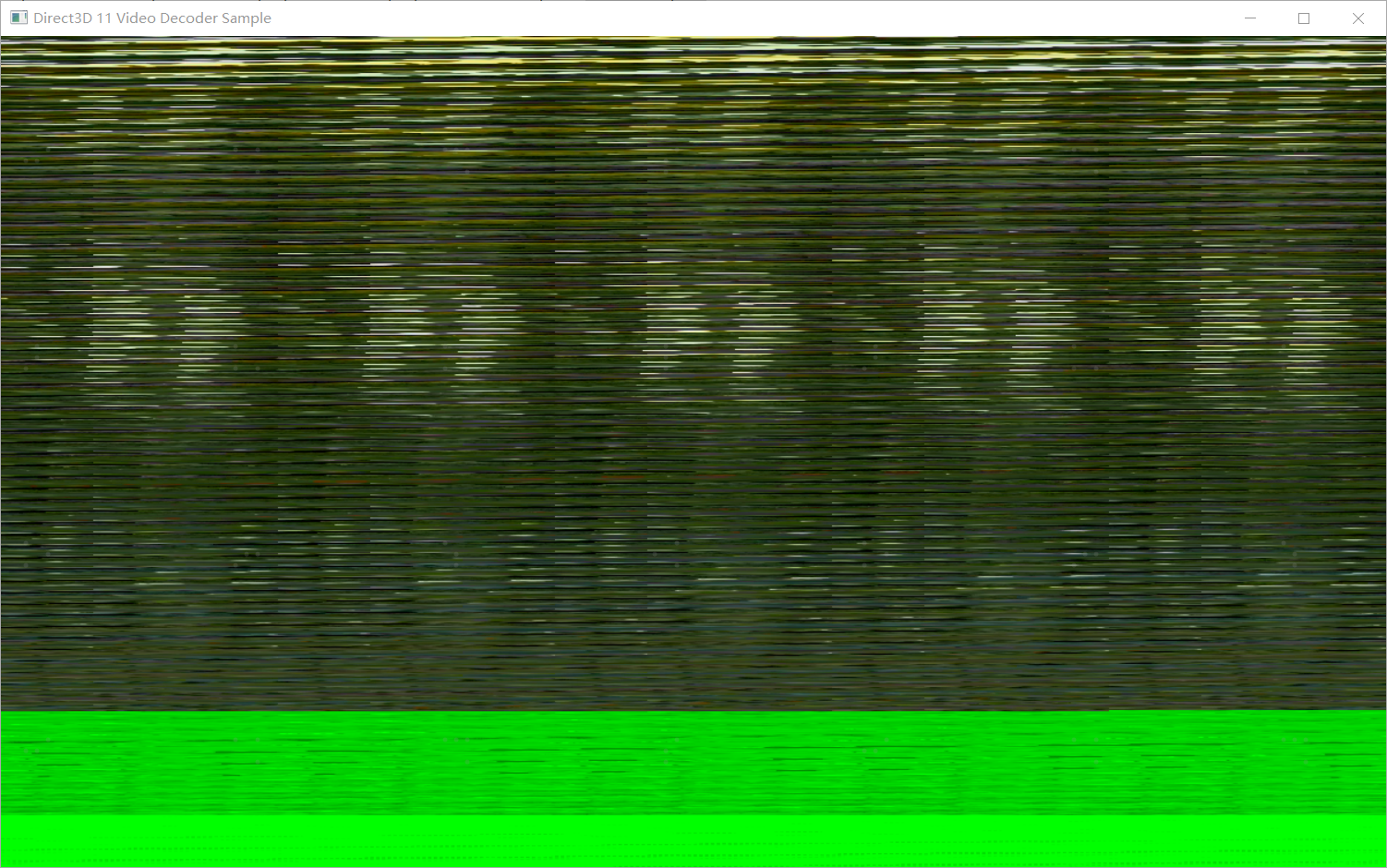I want to use D3D11 VideoProcessor to render a decoded video, but i found when video's height is like 1080, 360, such as height cannot satisfy mod16, the render result will be blurred screen, but 720, 4k will be ok.
I tried to input a 1080p bmp file and convert to nv12 format then copy to GPU texture2D, same result.

Here is my sample code, just similiar with Windows-classic-samples DX11VideoRenderer.
By the way, i also tested DX11VideoRenderer with topoedit, the 1080p video render result is normal, so i copy the frame texture from GPU to CPU and convert to ARGB then saved to bmp file, the bmp file is similiar with above photo.
I don't know how this happened, maybe something about data structuring. Is there a method to map NV12 data from 1080p frame to texture2d buffer correctly?
HRESULT CD3D11VideoProcessor::ProcessImagePresent(CWICBitmap& cWICBitmap)
{
HRESULT hr = S_OK;
ID3D11VideoProcessorInputView* pD3D11VideoProcessorInputViewIn = NULL;
ID3D11VideoProcessorOutputView* pD3D11VideoProcessorOutputView = NULL;
ID3D11VideoDevice* pD3D11VideoDevice = NULL;
ID3D11Texture2D* pInTexture2D = NULL;
ID3D11Texture2D* pOutTexture2D = NULL;
IF_FAILED_RETURN(m_pD3D11VideoContext == NULL ? E_UNEXPECTED : S_OK);
try
{
IF_FAILED_THROW(m_pD3D11Device->QueryInterface(__uuidof(ID3D11VideoDevice), reinterpret_cast<void**>(&pD3D11VideoDevice)));
D3D11_TEXTURE2D_DESC desc2D;
desc2D.Width = cWICBitmap.GetWidth();
desc2D.Height = cWICBitmap.GetHeight();
desc2D.MipLevels = 1;
desc2D.ArraySize = 1;
desc2D.Format = DXGI_FORMAT_B8G8R8A8_UNORM;
desc2D.SampleDesc.Count = 1;
desc2D.SampleDesc.Quality = 0;
desc2D.Usage = D3D11_USAGE_DEFAULT;
desc2D.BindFlags = D3D11_BIND_RENDER_TARGET;
desc2D.CPUAccessFlags = 0;
desc2D.MiscFlags = 0;
IF_FAILED_THROW(cWICBitmap.Create2DTextureFromBitmap(m_pD3D11Device, &pInTexture2D, desc2D));
desc2D.Format = DXGI_FORMAT_NV12;
IF_FAILED_THROW(m_pD3D11Device->CreateTexture2D(&desc2D, NULL, &pOutTexture2D));
D3D11_VIDEO_PROCESSOR_INPUT_VIEW_DESC pInDesc;
ZeroMemory(&pInDesc, sizeof(pInDesc));
pInDesc.FourCC = 0;
pInDesc.ViewDimension = D3D11_VPIV_DIMENSION_TEXTURE2D;
pInDesc.Texture2D.MipSlice = 0;
pInDesc.Texture2D.ArraySlice = 0;
D3D11_VIDEO_PROCESSOR_OUTPUT_VIEW_DESC pOutDesc;
ZeroMemory(&pOutDesc, sizeof(pOutDesc));
pOutDesc.ViewDimension = D3D11_VPOV_DIMENSION_TEXTURE2D;
pOutDesc.Texture2D.MipSlice = 0;
// process to present
D3D11_MAPPED_SUBRESOURCE MappedSubResource;
UINT uiSubResource = D3D11CalcSubresource(0, 0, 0);
ID3D11Texture2D* pARGBTexture = NULL;
pInTexture2D->GetDesc(&desc2D);
desc2D.BindFlags = 0;
desc2D.CPUAccessFlags = D3D11_CPU_ACCESS_READ;
desc2D.Usage = D3D11_USAGE_STAGING;
desc2D.MiscFlags = 0;
IF_FAILED_THROW(m_pD3D11Device->CreateTexture2D(&desc2D, NULL, &pARGBTexture));
m_pD3D11DeviceContext->CopyResource(pARGBTexture, pInTexture2D);
IF_FAILED_THROW(m_pD3D11DeviceContext->Map(pARGBTexture, uiSubResource, D3D11_MAP_READ, 0, &MappedSubResource));
BYTE* src = new BYTE[desc2D.Width * desc2D.Height * 6 / 4];
BYTE* src_y = src;
BYTE* src_uv = src_y + desc2D.Width * desc2D.Height;
libyuv::ARGBToNV12((BYTE*)MappedSubResource.pData, MappedSubResource.RowPitch,
src_y, desc2D.Width,
src_uv, desc2D.Width,
desc2D.Width, desc2D.Height);
m_pD3D11DeviceContext->Unmap(pARGBTexture, uiSubResource);
SAFE_RELEASE(pARGBTexture);
// create nv12 texture
ID3D11Texture2D* pNV12Texture = NULL;
desc2D.CPUAccessFlags = D3D11_CPU_ACCESS_WRITE;
desc2D.Usage = D3D11_USAGE_STAGING;
desc2D.MiscFlags = 0;
desc2D.Format = DXGI_FORMAT_NV12;
IF_FAILED_THROW(m_pD3D11Device->CreateTexture2D(&desc2D, NULL, &pNV12Texture));
IF_FAILED_THROW(m_pD3D11DeviceContext->Map(pNV12Texture, uiSubResource, D3D11_MAP_WRITE, 0, &MappedSubResource));
BYTE* dst = (BYTE*)MappedSubResource.pData;
memcpy(dst, src, desc2D.Width * desc2D.Height * 6 / 4);
m_pD3D11DeviceContext->Unmap(pNV12Texture, uiSubResource);
SAFE_DELETE(src);
m_pD3D11DeviceContext->CopyResource(pOutTexture2D, pNV12Texture);
RenderNV12Texture(pOutTexture2D);
ID3D11Texture2D* dxgi_back_buffer = NULL;
hr = m_SwapChain->GetBuffer(0, __uuidof(ID3D11Texture2D), (void**)&dxgi_back_buffer);
IF_FAILED_THROW(pD3D11VideoDevice->CreateVideoProcessorInputView(pOutTexture2D, m_pD3D11VideoProcessorEnumerator, &pInDesc, &pD3D11VideoProcessorInputViewIn));
IF_FAILED_THROW(pD3D11VideoDevice->CreateVideoProcessorOutputView(dxgi_back_buffer, m_pD3D11VideoProcessorEnumerator, &pOutDesc, &pD3D11VideoProcessorOutputView));
D3D11_VIDEO_PROCESSOR_STREAM stream_data;
ZeroMemory(&stream_data, sizeof(stream_data));
stream_data.Enable = TRUE;
stream_data.OutputIndex = 0;
stream_data.InputFrameOrField = 0;
stream_data.PastFrames = 0;
stream_data.FutureFrames = 0;
stream_data.ppPastSurfaces = nullptr;
stream_data.ppFutureSurfaces = nullptr;
stream_data.pInputSurface = pD3D11VideoProcessorInputViewIn;
stream_data.ppPastSurfacesRight = nullptr;
stream_data.ppFutureSurfacesRight = nullptr;
stream_data.pInputSurfaceRight = nullptr;
IF_FAILED_THROW(m_pD3D11VideoContext->VideoProcessorBlt(m_pD3D11VideoProcessor, pD3D11VideoProcessorOutputView, 0, 1, &stream_data));
hr = m_SwapChain->Present(1, 0);
SAFE_RELEASE(pNV12Texture);
SAFE_RELEASE(dxgi_back_buffer);
}
catch (HRESULT) {}
SAFE_RELEASE(pOutTexture2D);
SAFE_RELEASE(pInTexture2D);
SAFE_RELEASE(pD3D11VideoProcessorOutputView);
SAFE_RELEASE(pD3D11VideoProcessorInputViewIn);
SAFE_RELEASE(pD3D11VideoDevice);
return hr;
}
